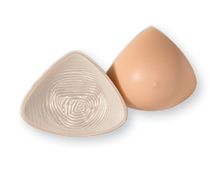- Home
- Cancer Information
- Managing side effects
- Breast prostheses and reconstruction
- Breast prostheses
- Types of prostheses
Types of prostheses
This section explores the different types of prostheses that may be available.
Learn more about:
Overview
As everyone is different, prostheses are available in a variety of:
- shapes (triangles, circles or teardrops)
- cup sizes (shallow, average or full)
- skin tones.
If you have breast-conserving surgery, you can wear a partial breast prosthesis (triangle, oval, curve or shell) to regain breast symmetry. These are also called balance shapers.
Different prostheses have different amounts or layers of silicone. This allows you to match the breast prosthesis to the structure and movement of your remaining breast.
Symmetrical prostheses are even on both sides and can be worn on either the left or right side of the body. Asymmetrical prostheses are designed specifically for the left or right side.
The type of prosthesis you can wear will depend on the amount and location of tissue removed during surgery. You should be able to find one that is close to your original breast shape and suits your lifestyle. For information on the different types of breast prostheses available, see below. Your fitter will be able to guide you through the range of prostheses that are suitable for you.
Different breast prostheses and their features
Soft breast prosthesis

| When used | Immediately after surgery; during leisure time or sleeping |
| How used | Worn in a pocketed bra |
| Material | Polyester front cover and cotton back cover |
| Weight | Lightweight |
| Special features | Breathable cotton back layer to maintain ideal body temperature |
| Other considerations | Not a suitable substitute for a weighted silicone form that provides the body with balance |
Three-layer breast prosthesis

| When used | Everyday use |
| How used | Worn in a pocketed bra |
| Material | 3 layers of silicone to help the prosthesis drape and move more realistically for the type of breast it is matching, such as a younger or an older breast |
| Weight | Regular weighted silicone |
| Special features | May include technology to maintain ideal body temperature |
| Other considerations | Symmetrical shape – can be worn on either the left or right side |
Partial breast prosthesis

| When used | After breast-conserving surgery or if breast changes shape after radiation therapy |
| How used | Can be worn in your usual bra cup |
| Material | 2 layers of silicone |
| Weight | Regular weighted silicone |
| Special features | Extra soft silicone, covered with a thin film to cling gently to the breast; includes temperature-regulating technology |
| Other considerations | Available in a variety of shapes and sizes to replace the missing breast tissue and to achieve symmetry |
Lightweight breast prosthesis

| When used | Everyday use |
| How used | Worn in a pocketed bra |
| Material | Slightly firmer lightweight silicone in the back layer helps keep the prosthesis in place when worn in a bra pocket |
| Weight | Weighs 40% less than a standard silicone prosthesis |
| Special features | Back layer includes temperature-regulating material; available in different colours |
| Other considerations | Designed to drape like a natural breast; moves with the body and flattens when you lie down |
Attachable or contact breast prosthesis

| When used | Everyday use |
| How used | Attachable; adheres to the chest wall |
| Material | Standard silicone layer with super soft film |
| Weight | Lightweight |
| Special features | Designed with a lower-cut inside edge for use when surgery has conserved a small area of cleavage |
| Other considerations | Follows body movements naturally; suits figure-hugging clothes |
Adjustable breast prosthesis

| When used | Everyday use |
| How used | Worn in a pocketed bra |
| Material | Lightweight or ultra-lightweight silicone |
| Weight | Weighs up to 40% less than a standard silicone prosthesis |
| Special features | Has a built-in air chamber that you can adjust to ensure a close fit and good skin contact |
| Other considerations | Provides comfort if your chest wall is uneven |
Swim form

| When used | When swimming |
| How used | Worn inside the pocket of a swimsuit |
| Material | Lightweight pale blue silicone |
| Weight | 30% lighter than a standard prosthesis |
| Special features | Resistant to salt water and chlorine; quick drying |
| Other considerations | Water moves behind the prosthesis to make it more comfortable |
→ READ MORE: Buying a breast prosthesis
Podcast: Coping with a cancer diagnosis
Listen to more of our podcast for people affected by cancer
More resources
Dr Jane O’Brien, Specialist Oncoplastic Breast Cancer Surgeon, St Vincent’s Private Hospital, VIC; Clare Bradshaw, Clinical Nurse Consultant, Breast Assessment Unit, Fiona Stanley Hospital, WA; Rene Hahn, Consumer; Sinead Hanley, Consumer; Dr Marc Langbart, Specialist Plastic and Reconstructive Surgeon, Randwick Plastic Surgery, NSW; Melanie Law, Consumer; Sally Levy, Consumer; Annmaree Mitchell, Consumer; Ashleigh Mondolo, Breast Cancer Nurse Clinical Consultant, Mater Private Hospital Brisbane, QLD; Rochelle Osgood, Clinical Nurse Consultant – McGrath Breast Care Nurse, Sunshine Coast University Hospital, QLD: Dr Kallyani Ponniah, Head of Department, Breast Centre, Sir Charles Gairdner Hospital, WA; Meg Rynderman OAM, Consumer; Sarah Stewart, Breast Care Nurse, The Royal Women’s Hospital, VIC; Erin Tidball, 13 11 20 Consultant, Cancer Council NSW; Jane Turner, Senior Exercise Physiologist, Sydney Cancer Survivorship Centre, Concord Cancer Centre, NSW.
We are grateful to Amoena Australia Pty Ltd for supplying the breast form images above.
View the Cancer Council NSW editorial policy.
View all publications or call 13 11 20 for free printed copies.



